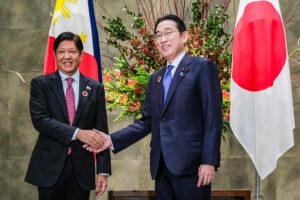Philippines, Japan agree to rush talks for mutual defense pact

By Kyle Aristophere T. Atienza, Reporter
STRONG allies, the Philippines and Japan have agreed to quicken talks on a possible deal that would give Japanese security forces easier access to facilities in the Southeast Asian nation.
President Ferdinand R. Marcos, Jr. and Japanese Prime Minister Fumio Kishida “concurred to continue coordination to reach an early conclusion of the negotiations of the Reciprocal Access Agreement (RAA),” the Japanese Foreign Ministry said in a statement following the two leaders’ meeting on the sidelines of a Japan-ASEAN summit in Tokyo.
“The two leaders also agreed to enhance cooperation between the coast guards of the two countries,” the ministry added.
The Philippine leader said the possible reciprocal agreement will give his country “greater capability in terms of not only security, but also in terms of disaster preparedness and alleviation.”
“That is something that really is very, very significant to us and will bring to us a greater capacity to maintain the peace in the South China Sea,” he told Mr. Kishida.
In early November, the two countries agreed to begin formal talks on the proposed RAA, which is similar to Manila’s Visiting Forces Agreement with the United States and the Status of Visiting Forces Agreement with Australia.
Also on Sunday, Mr. Marcos and Mr. Kishida witnessed the signing of a memorandum of cooperation between the Philippine Coast Guard and the Japanese Coast Guard, which came on the heels of China’s intrusions into Philippine waters in the South China Sea.
In addition, a memorandum of cooperation was also exchanged between the two countries’ environmental agencies. PHL MUST BRACES FOR MORE AGGRESSIVE CHINA – EXPERTS The Philippines should brace for a more aggressive China as it tests the limits of the Manila’s mutual defense treaty with Washington, experts said on Sunday following an unusual swarming of Chinese ships inside Second Thomas Shoal last week.
“China’s actions and its rhetoric indicate they will continue to escalate this situation in the belief that Manila’s resolve will break,” Raymond M. Powell, SeaLight director at the US-based Gordian Knot for National Security Innovation, said in an X message.
From increasing the strength of its blockade, stationing vessels inside the shoal, to Chinese media articles advocating for a more muscular policy, “it seems clear that Beijing has not yet reached the point at which it is looking for off-ramps.” Mr. Powell reported last week that as many as 11 Chinese maritime militia vessels were inside Second Thomas Shoal while dozens more were clustered in the periphery on Dec. 11, just a day after the Chinese coast guard fired water cannons at Philippine resupply boats in the same waters.
He then described the Dec. 11 incident as an “unusual invasion of the shoal’s interior,” which he said “appeared to have been a calculated show of force by Beijing.”
But on Dec. 15, the Philippine military’s western command said the intensified swarming of Chinese vessels in Second Thomas Shoal cannot be considered an “invasion” yet.
While there was a continuation of Beijing’s “swarming tactics” in the area where the BRP Sierra Madre is grounded, it may be premature to call it an invasion, the command’s spokesperson, Ariel Joseph Coloma, said.
“As far as we are concerned, what we are seeing on the ground are the same old swarming tactics employed by the Chinese,” he told reporters.
But on Sunday, Mr. Powell said the actions of China have been “pushing the limits of ‘armed attack’ on Philippine public vessels, which would invoke Article IV of the Mutual Defense Treaty.”
The 1951 Mutual Defense Treaty compels both countries to defend each other in case of an armed attack on their armed forces, vessels, and aircraft, among other assets.
The US and its former colony in May agreed on new guidelines for the treaty, with new provisions stating that the mutual defense commitments would be invoked if there were an armed attack on either country “anywhere in the South China Sea.”
The new guidelines also specified that coast guard vessels are covered by the treaty.
The two countries need to consider “asymmetric, hybrid and irregular warfare and grey zone tactics,” according to the new guidelines.
Chinese coast guard and maritime militia vessels have been banking on non-military means, including blockades and dangerous maneuvers, to assert the expansive claims of Beijing in the South China Sea that a United Nations tribunal invalidated in 2015.
Mr. Powell said the Philippines and the US need to discuss means of making clear to China the “real risks of continuing its escalation.”
China wants to show that “it can get away with its belligerence in Philippine waters,” Don Mclain Gill, who teaches international relations at De La Salle University, said following the unusual swarming of Chinese vessels in Second Thomas Shoal.
“It also wants to prove how the Philippines-US alliance is unable to address its assertiveness and provocations in the West Philippine Sea,” he said in a Facebook Messenger chat.
Mr. Gill said China might also be trying to bend Manila’s “reinvigorated political will” to stand up for its national interest.
“It is likely that Beijing will continue this strategy of trying to wear down its victim.”
Armed Forces of the Philippines (AFP) Chief of Staff Romeo S. Brawner, Jr. and AFP Western Command chief Alberto B. Carlos were on board the small and wooden “Unaizah Mae 1” when it was rammed by the Chinese Coast Guard on Dec. 10 while the Philippine side was delivering food and supplies for its troops stationed on BRP Sierra Madre.
The incident, in which China used water cannons that seriously damaged a Philippine vessel, prompted discussions on whether or not Beijing had committed an act of war.
Following the Dec. 10 stand-off, the Philippine security sector said Manila was eyeing a new national strategy in the South China Sea to include “some adjustments.”
“We have to make some adjustments given the recent developments and we hope to be able to present this to the President very soon,” National Security Council Assistant Director-General Jonathan E. Malaya said last week.
BRP Sierra Madre, a World War II-era vessel, was grounded in Second Thomas Shoal in 1999 to serve as an outpost for Filipino troops following China’s seizure of Mischief Reef three years earlier.
Victor Andres C. Manhit, president of Manila-based think tank Stratbase ADR Institute, called for national attention on the condition of BRP Sierra Madre, saying the Philippines would lose its control of the shoal once the ship becomes uninhabitable.
“As the primary outpost in the West Philippine Sea, it is critical for the Philippines to refurbish BRP Sierra Madre,” he said in an e-mail.
The restoration of BRP Sierra Madre was among the highlights of the proposed P5.768-trillion 2024 national budget, which was ratified by Congress on Dec. 11, months after the House of Representatives stripped several non-security departments of their confidential and intelligence funds to bolster the Philippines’ presence in the South China Sea.
In August, Senator Francis Joseph “Chiz” G. Escudero said he would push for the allocation of at least P100 million for the restoration of BR Sierra Madre.




